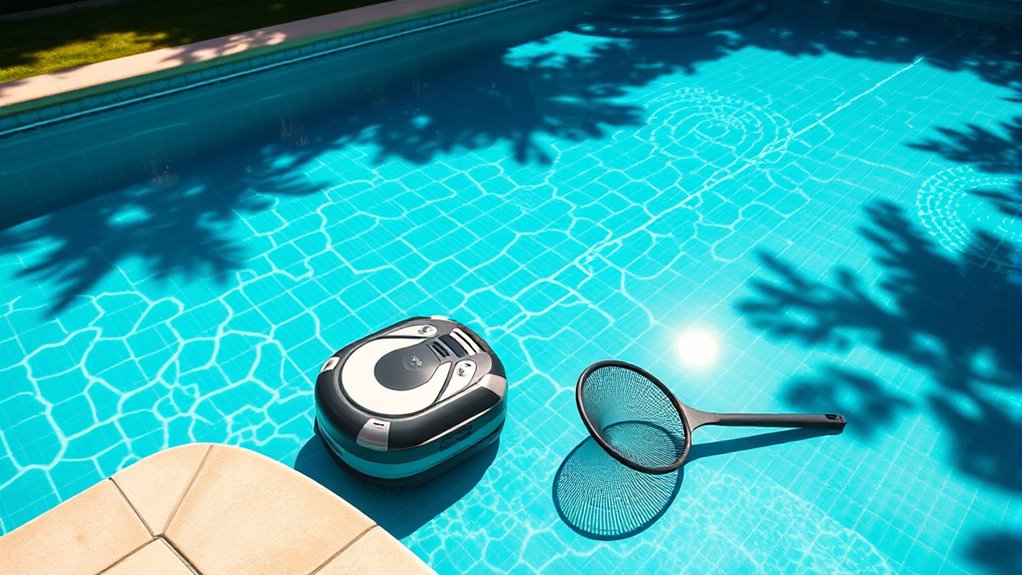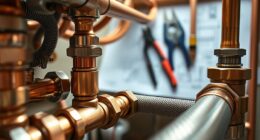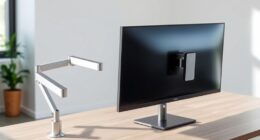Choosing between automatic and manual pool cleaning depends on your needs and budget. Automatic cleaners offer hands-free operation, save time, and work well for large or frequently used pools, but they come with higher upfront costs and some navigation limits. Manual cleaning gives you precise control, is cheaper initially, and suits small or rarely used pools, though it requires more effort and can be less thorough. Keep exploring to find the best fit for your pool’s size and usage.
Key Takeaways
- Automatic cleaners offer hands-free operation, consistent cleaning, and are cost-effective over time for large or high-usage pools.
- Manual cleaning provides targeted control, lower initial costs, and is ideal for small or infrequent-use pools.
- Automatic systems typically have higher upfront costs but reduce ongoing labor and maintenance expenses.
- Manual cleaning can be labor-intensive, less thorough, and may lead to uneven chemical distribution.
- Consider pool size, usage frequency, and budget to choose the most suitable method for efficient, cost-effective cleaning.
Overview of Pool Cleaning Methods
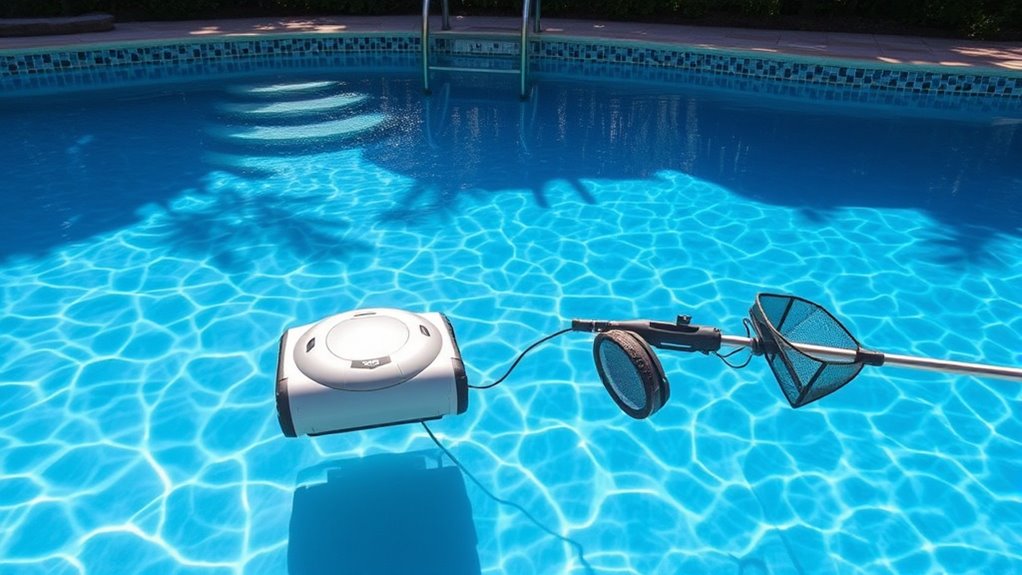
Pool cleaning methods generally fall into two main categories: automatic and manual. With automatic systems, devices like robotic cleaners handle most of the work, often improving water circulation and reducing the need for frequent chemical adjustments. These cleaners typically operate on timers, skimming surfaces and filtering debris efficiently. Additionally, automatic cleaners can contribute to water quality by providing consistent circulation, which helps prevent algae growth and maintain clarity. Manual cleaning, on the other hand, requires you to physically scrub the pool walls, vacuum the floor, and manage water circulation through your pump and skimmers. It allows you to target specific areas and ensure proper distribution of pool chemicals. Both methods impact water quality, but automatic cleaners often provide more consistent circulation, helping to maintain balanced chemical levels. Choosing between them depends on your budget, pool size, and how much you want to be involved in the cleaning process. Color accuracy in water circulation and filtration can also influence overall water clarity and quality.
Benefits of Manual Pool Cleaning
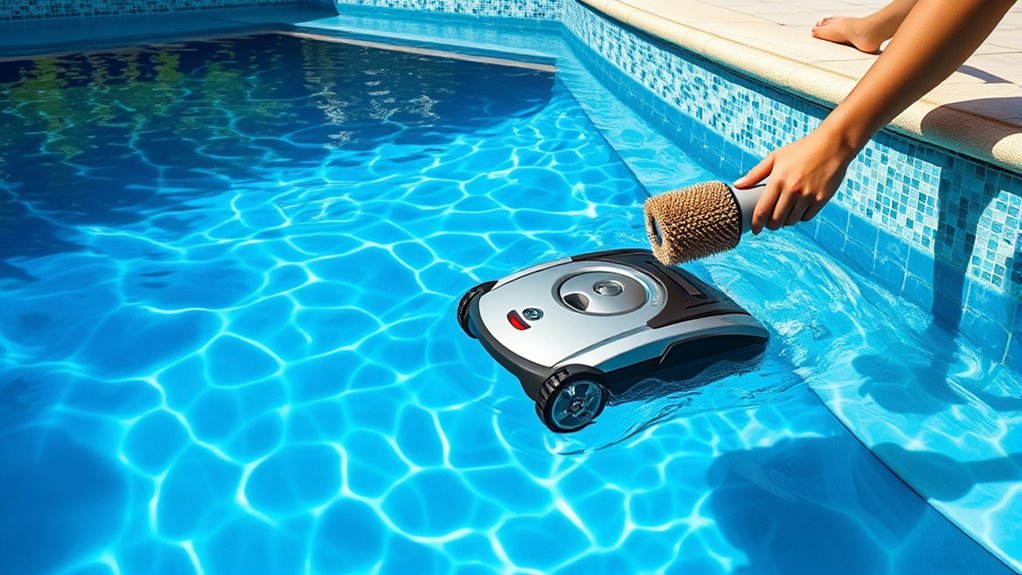
Manual pool cleaning lets you target specific areas that need attention, ensuring a thorough clean. You have greater control over removing debris and dirt, which helps keep your pool pristine. This method is especially effective for small pools, where detailed cleaning makes a noticeable difference. Additionally, manual cleaning can be customized to include safety considerations, ensuring the process remains safe and effective. For example, understanding proper handling of pool equipment can prevent injuries and damage during cleaning. Incorporating modern maintenance tools can further streamline the process and improve safety. Being mindful of space and organization can also help in setting up an efficient cleaning station and storing equipment properly. Recognizing the importance of visual and auditory cues can enhance cleaning accuracy and efficiency.
Precise Spot Cleaning
While automatic cleaners can handle large surface areas efficiently, they often miss stubborn dirt and small debris in specific spots. This is where manual cleaning shines, giving you the ability to target precise areas missed by machines. You can focus on spots with imbalanced chemical levels or poor water filtration, ensuring your pool remains crystal clear. Manual cleaning allows you to scrub corners, steps, or tight spaces that are difficult for automatic devices to reach. This detailed approach helps maintain proper chemical balance, preventing algae growth and reducing the risk of cloudy water. By personally spot cleaning, you ensure every inch of your pool receives attention, resulting in better water quality and a more inviting swimming environment. Additionally, manual cleaning can help identify AI vulnerabilities in your pool’s filtration system, allowing for targeted repairs and enhanced safety. Regular manual spot cleaning also supports proper water circulation, ensuring that chemicals are evenly distributed and that the entire pool remains clean.
Greater Control Over Debris
Manual cleaning gives you greater control over debris because you can precisely target and remove particles that automatic cleaners might miss or overlook. With manual effort, you can focus on areas where debris tends to accumulate, like corners or steps, ensuring a thorough clean. This hands-on approach improves filter efficiency by reducing the amount of debris that reaches your filter, preventing clogs and maintaining clearer water. You can also adjust your cleaning intensity based on debris levels or specific needs, making your efforts more effective. Unlike automatic cleaners, which operate on preset patterns, manual cleaning allows you to respond dynamically to debris buildup. Additionally, manual cleaning promotes proper pool maintenance by allowing you to regularly inspect and address potential issues directly. Incorporating filter protection strategies during manual cleaning can extend the lifespan of your equipment and improve overall performance. Effective debris removal is essential for maintaining water clarity and health. Overall, this control helps keep your pool cleaner and your filtration system running smoothly.
Suitable for Small Pools
A small pool makes manual cleaning particularly practical because it requires less time and effort compared to larger pools. With fewer square feet to cover, you can easily maintain the chemical balance and check your pool equipment regularly. Manual cleaning allows you to target specific areas that may develop algae or debris, ensuring a thorough clean. It also gives you direct control over the water quality, helping you adjust chemical levels as needed. Small pools often lack complex pool equipment, making it easier to manage cleaning without relying on expensive gadgets. Plus, you avoid the potential malfunction of automatic systems for a pool of this size. Overall, manual cleaning is a straightforward, cost-effective way to keep your small pool pristine. Additionally, understanding proper pool maintenance techniques can help prevent running dry and ensure your pool remains in optimal condition.
Drawbacks of Manual Cleaning Systems
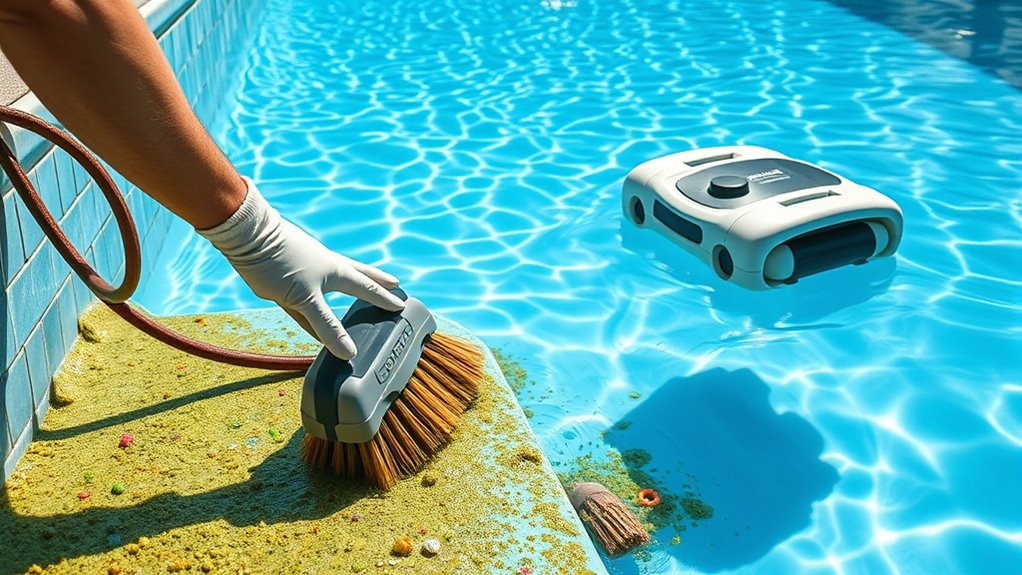
Manual cleaning systems often fall short because they demand significant time and effort from you. You’ll spend hours skimming debris, brushing walls, and emptying skimmer baskets. This process can be exhausting and inconsistent, leading to uneven cleaning. Additionally, manual methods make it harder to maintain proper water chemistry. You need to regularly test water and adjust pool chemicals, but neglecting these steps can cause algae growth or cloudy water. Manual cleaning also doesn’t reach hidden spots, allowing dirt and bacteria to accumulate. This means more frequent maintenance and increased risk of water quality issues. Overall, relying solely on manual systems can be labor-intensive, time-consuming, and less effective at keeping your pool pristine and safe. Incorporating professional guidance can help improve maintenance routines and ensure better water quality, especially since manual cleaning often overlooks hidden spots where dirt can build up. Furthermore, manual cleaning may not be sufficient to handle seasonal changes that affect water clarity and chemical balance, which can be mitigated with automated cleaning systems that adapt to varying conditions.
A new sentence to consider adding: Regular inspection and maintenance of equipment can also prevent unexpected breakdowns and extend the lifespan of your cleaning tools, enhancing overall efficiency.
Advantages of Automatic Pool Cleaners
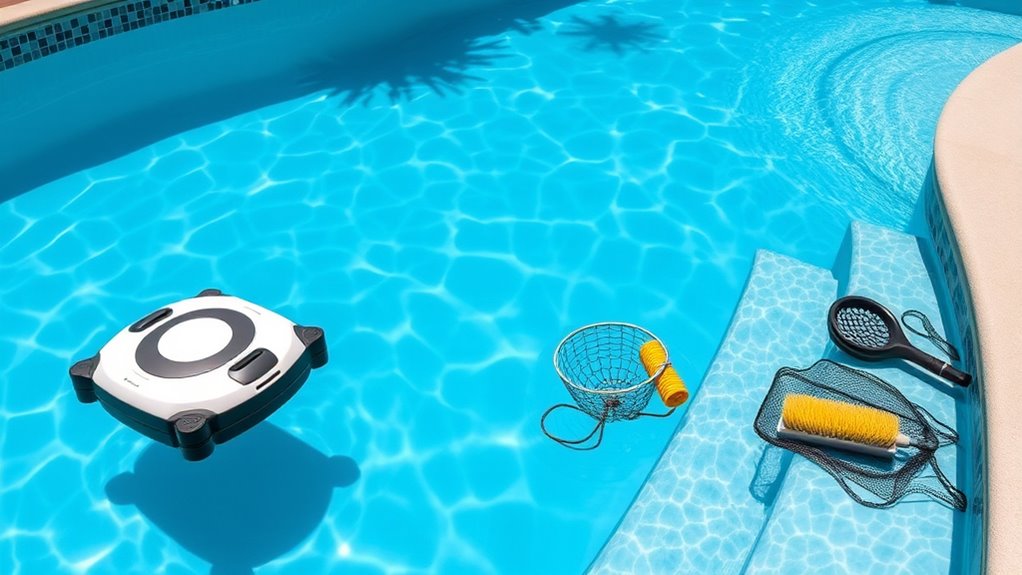
Automatic pool cleaners offer a highly efficient way to keep your pool spotless without constant effort. They save you time and energy by consistently removing debris and dirt, which helps maintain ideal water quality. When your pool stays clean, it promotes better pool safety by reducing slip hazards and preventing algae buildup. Automated cleaners also help maintain proper chemical balance because fewer contaminants enter the water, making chemical adjustments easier and more effective. This consistency minimizes the risk of algae growth or bacteria, ensuring a safer swimming environment. With automatic cleaners, you can enjoy a cleaner pool with less manual labor while supporting overall pool health, safety, and proper chemical levels. Additionally, regular use of automated cleaners can reduce the need for frequent chemical treatments, contributing to a healthier swimming environment. Many models also feature automatic operation settings that allow for scheduled cleaning, further reducing your maintenance effort. Furthermore, advancements in robotic technology have led to more intelligent cleaners that adapt to different pool shapes and sizes, enhancing their efficiency and coverage.
Limitations of Robotic and Automatic Devices
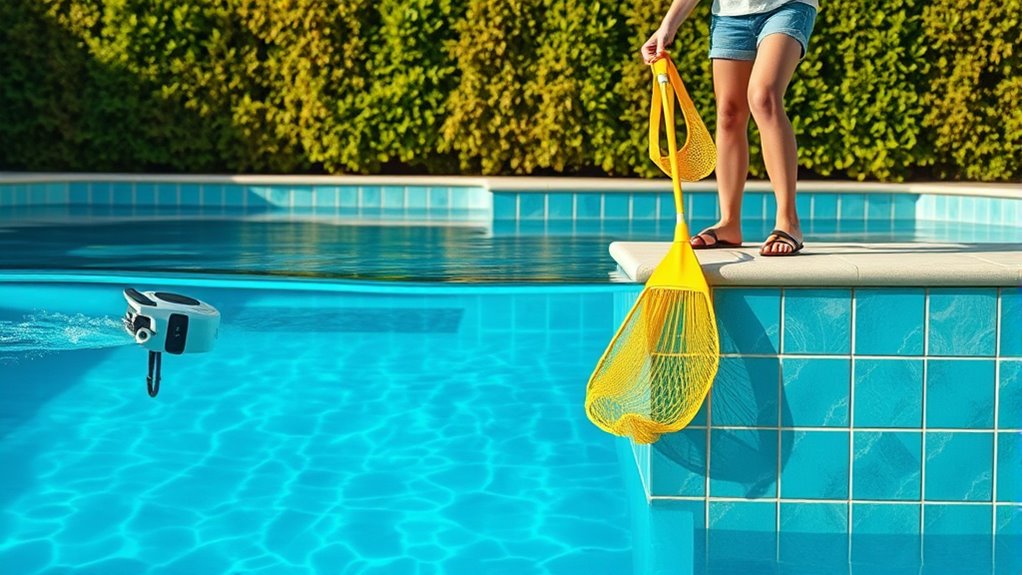
While automatic pool cleaners offer many benefits, they also come with notable limitations. One major issue is sensor limitations, which can hinder their ability to detect obstacles or specific areas that need cleaning. This often results in missed spots or inefficient coverage. This challenge is compounded by the fact that technology continues to improve, but current models still face significant hurdles. Navigation challenges also pose problems; robotic cleaners may struggle with complex pool shapes, steps, or shallow areas, causing them to get stuck or miss sections entirely. Additionally, some devices lack advanced mapping features, leading to random or inefficient cleaning paths. These limitations mean you might need to supervise the cleaning process or manually intervene to ensure thorough coverage. Furthermore, smart technology integration is still developing, which could enhance their capabilities in future models. Improving sensor accuracy and navigation algorithms remains a priority for manufacturers aiming to overcome these issues. Moreover, ongoing research in automated cleaning systems is expected to deliver more reliable and efficient solutions in the near future.
Cost Analysis: Manual vs. Automatic Cleaning
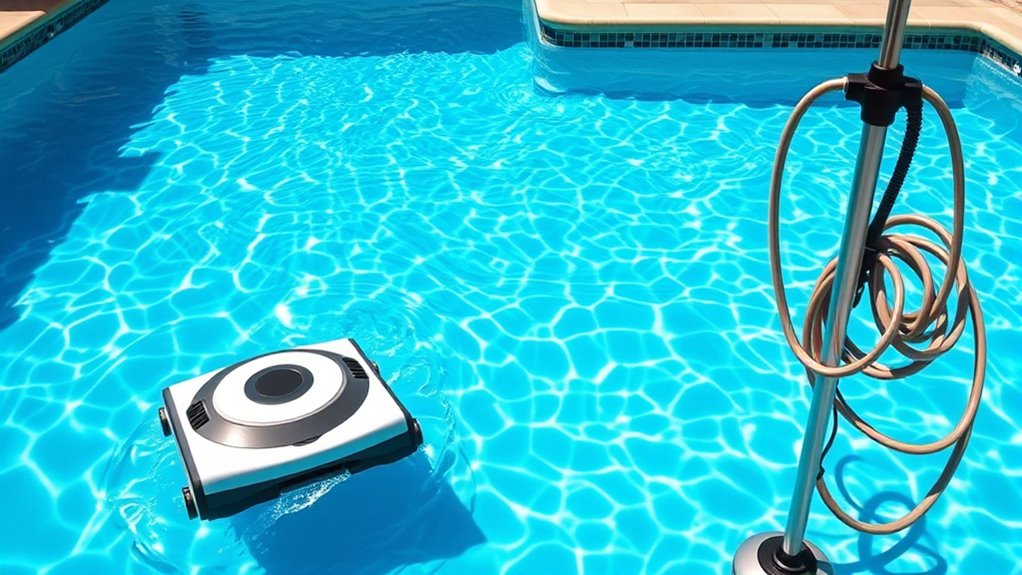
When comparing the costs of pool cleaning methods, it’s important to contemplate both upfront expenses and ongoing maintenance. Manual cleaning typically involves lower initial costs since you only need basic tools like a brush and skimmer. However, it demands more time and effort, which can add up over the long run. Automatic cleaners, especially robotic models, require a higher upfront investment, but they often deliver better cost efficiency through reduced labor and consistent cleaning. From a user convenience perspective, automatic systems save you time and effort, offering a more effortless experience. While manual cleaning might seem cheaper initially, automatic devices can be more economical over time due to less maintenance and fewer replacement parts, making them a smarter choice for those valuing convenience and long-term savings.
Maintenance and Operational Expenses
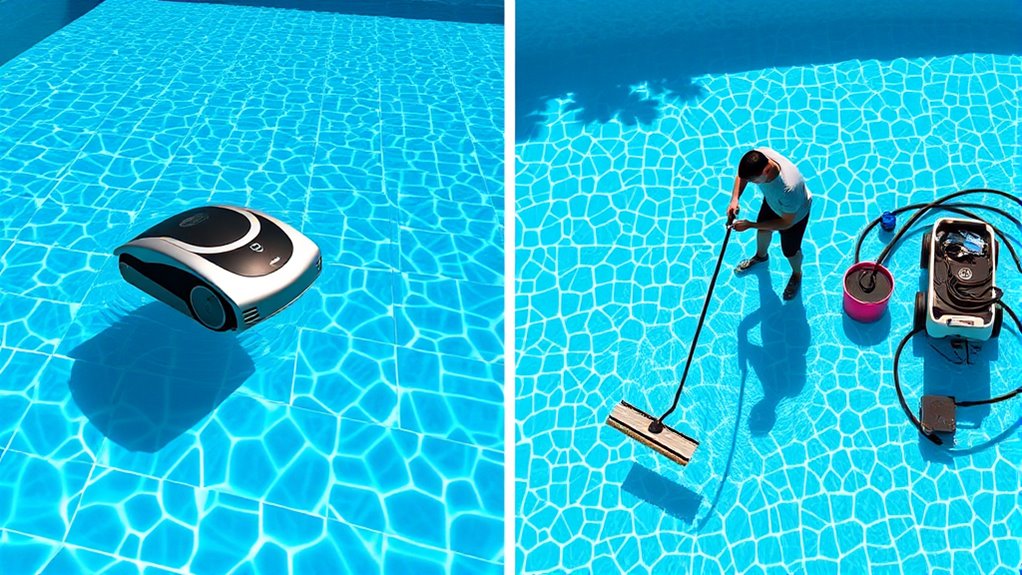
When considering maintenance and operational expenses, you’ll want to compare equipment costs and how long they last. Energy consumption varies between manual and automatic cleaners, affecting your ongoing bills. Additionally, you’ll need to account for repair needs that can impact both types over time.
Equipment Costs and Lifespan
Automatic pool cleaners generally have higher upfront equipment costs but tend to offer lower ongoing maintenance expenses over their lifespan. You’ll find that their durability impacts overall costs, especially regarding the pool filter lifespan. These cleaners often reduce the strain on your filter system, extending its usable life and decreasing replacement costs. Manual cleaners, on the other hand, usually have lower initial prices but can cause more wear on filters due to inconsistent cleaning, leading to more frequent replacements. Over time, this can make manual options more expensive. When considering equipment costs, factor in not just the purchase price but also how long the equipment lasts and how often you’ll need to replace parts like filters. This helps you gauge the true long-term expenses of each cleaning method.
Energy Consumption Differences
While automatic pool cleaners often require more energy to operate than manual options, they tend to run efficiently and for shorter periods, which can help control overall energy costs. Their electrical energy use varies based on device type and solar efficiency, impacting ongoing expenses. Automated cleaners typically use less energy over time due to optimized motors and smart operation schedules. Manual cleaning involves minimal electrical energy but requires physical effort. Consider the table below for a clearer comparison:
| Aspect | Automatic Cleaner | Manual Cleaning | Notes |
|---|---|---|---|
| Energy Consumption | Higher but efficient overall | Minimal electrical energy | Depends on duration and frequency |
| Solar Efficiency | Can supplement energy use | Not applicable | Solar-powered models available |
| Operating Time | Shorter, more frequent runs | None | Manual requires no device run time |
| Cost Implication | Higher initial, potentially lower ongoing | No ongoing energy costs | Long-term savings vary |
| Environmental Impact | Lower with solar options | Minimal | Focus on eco-friendliness |
Maintenance and Repair Needs
Maintenance and repair requirements substantially impact the long-term operational expenses of pool cleaning options. Automatic cleaners often have more complex components, such as advanced filtration systems and motors, which can require regular maintenance and occasional repairs. You’ll need to check and replace parts like pool chemicals and filters to keep the system functioning efficiently. Manual cleaning tools, on the other hand, tend to need less frequent repairs but demand more hands-on effort. Over time, neglecting maintenance can lead to issues like clogged filters or algae buildup, increasing costs. Regular inspection of your filtration system helps prevent costly repairs. Overall, automatic systems might save you time but could incur higher repair costs, while manual cleaning involves less technical repair but more frequent upkeep of pool chemicals and cleanliness.
Suitability Based on Pool Size and Usage
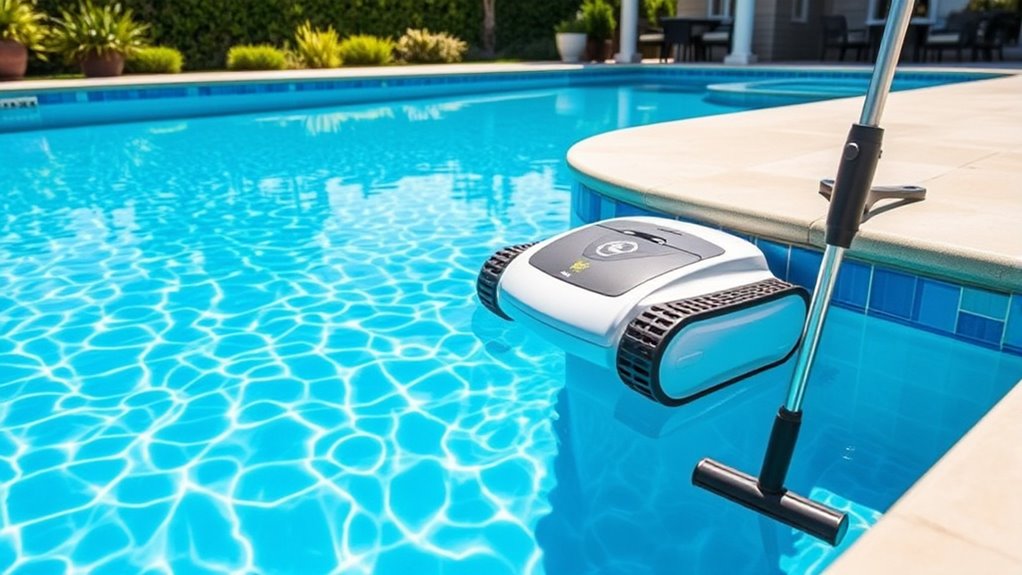
Choosing the right pool cleaning method depends heavily on your pool’s size and how often you use it. For smaller pools or those used frequently, manual cleaning might be more practical, allowing you to target specific areas and perform quick spot-cleaning as needed. Larger pools or pools with high usage frequency benefit from automatic cleaners, which can cover extensive surfaces efficiently with minimal effort. Pool size considerations play a vital role; automatic cleaners are designed to handle bigger surfaces without tiring out. Conversely, if your pool sees infrequent use and is small, manual cleaning could be sufficient and more cost-effective. Ultimately, evaluating your pool’s size and how often you use it helps determine whether an automatic or manual approach suits your needs best.
Making the Right Choice for Your Pool
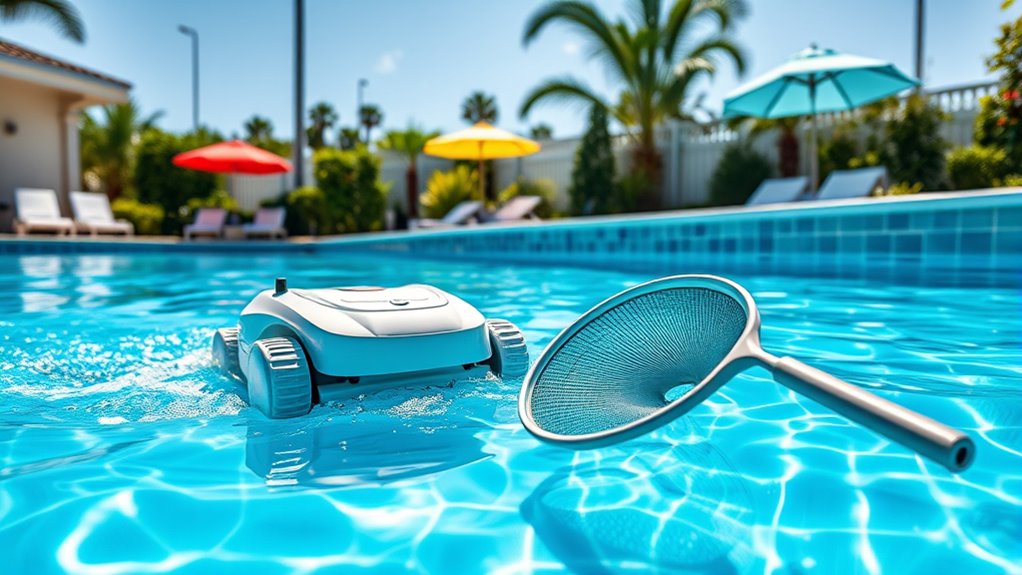
Deciding between an automatic and manual pool cleaner hinges on your specific needs, budget, and the level of effort you’re willing to invest. If you prefer convenience and consistent cleaning, an automatic cleaner paired with a reliable pool heater can keep your water warm and clear with minimal effort. Manual cleaning might suit someone who enjoys regular maintenance and wants control over chemical balancing. Consider how much time you want to spend on pool care and whether you’re comfortable adjusting chemical levels or just maintaining temperature.
Choosing between automatic and manual pool cleaners depends on your needs, budget, and desired effort level.
- Think about your pool’s size and shape for ideal cleaning efficiency
- Evaluate if you need a cleaner that supports chemical balancing or works with your pool heater
- Decide if you prefer hands-on control or automated convenience
Frequently Asked Questions
How Long Does Each Cleaning Method Typically Take?
When considering cleaning your pool, you wonder how long each method takes. Manual effort usually means a longer cleaning duration, often taking 1 to 2 hours depending on pool size and debris. Automatic cleaners are quicker, typically completing a cycle in 30 minutes to an hour. If you prefer thorough control, manual cleaning demands more time, but automatic options save you time and effort, making maintenance more convenient.
Are There Environmental Impacts Between Manual and Automatic Cleaners?
Think of your pool as a delicate ecosystem. Manual cleaners often use less energy, reducing energy consumption and chemical runoff, making them gentler on the environment. Automatic cleaners might save time but can use more electricity, increasing environmental impact. You’ll want to weigh the benefits of lower chemical runoff and energy use against convenience, choosing the method that aligns best with your eco-conscious values.
Can Automatic Cleaners Handle All Types of Pool Debris?
Automatic cleaners can handle most types of pool debris, but their effectiveness depends on your pool’s chemical balance and water circulation. If your water isn’t properly balanced, debris may not be fully removed, and poor circulation can hinder the cleaner’s performance. Regularly maintaining chemical levels and ensuring good water flow helps automatic cleaners do their job better, keeping your pool clean without manual effort.
What Safety Concerns Are Associated With Each Cleaning Method?
You should consider safety concerns with both cleaning methods. Automatic cleaners pose electrical safety concerns, so make certain of proper grounding and regular inspections to prevent shocks. Manual cleaning generally involves less risk but requires you to handle pool chemicals safely, avoiding splashes or inhalation. Always follow pool chemical safety guidelines and maintain equipment properly to minimize hazards. Both methods need careful attention to safety to keep your pool area secure.
How Do Maintenance Requirements Differ Over the Long Term?
You’ll find that maintenance frequency varies with each method. Automatic cleaners typically require less frequent attention, reducing long-term costs, but may need occasional repairs. Manual cleaning demands regular, hands-on maintenance, increasing ongoing effort and costs over time. If you prefer convenience, automatic options save you time and effort, though you should budget for potential repairs. Ultimately, consider how often you want to perform maintenance when choosing the best method for your pool.
Conclusion
Choosing between manual and automatic pool cleaning depends on your pool size, budget, and maintenance preferences. Did you know that robotic cleaners can cut cleaning time by up to 70%? By understanding the pros, cons, and costs, you can make an informed decision that keeps your pool sparkling with less effort. Whichever option you pick, maintaining a clean pool guarantees a more enjoyable swimming experience for you and your family.
